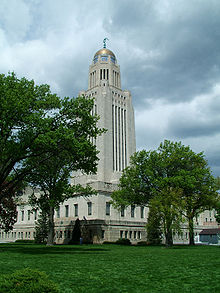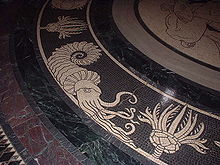- Nebraska State Capitol
-
Nebraska State Capitol
 The Nebraska State Capitol
The Nebraska State CapitolLocation: Lincoln, Nebraska Built: 1922-1932 Architect: Goodhue, Bertram Architectural style: Modern Governing body: State NRHP Reference#: 70000372[1] Significant dates Added to NRHP: October 16, 1970 Designated NHL: January 7, 1976[2] The Nebraska State Capitol, located in Lincoln, Nebraska, is the house of the Nebraska Legislature and houses other offices of the government of the U.S. state of Nebraska.
At 15 stories and 400 feet (121 m) tall, it is the second-tallest U.S. statehouse, surpassed only by the 34-story Louisiana State Capitol. It is the tallest building in Lincoln, and the third-tallest in the state. It is the heaviest building in Lincoln, as well as the heaviest capitol building of any sort in North America. There is an observation deck at 250 feet (76 m).
The building was designed by Bertram Grosvenor Goodhue, who drew upon Classical and Gothic architectural traditions. It was constructed between 1922 and 1932, of Indiana limestone.
Contents
History
The building succeeds two capitols of the Nebraska Territory in Omaha, both built in the 1850s, before Nebraska was admitted to the Union in 1867; and two state capitols, completed in 1868 and 1889, that had structural problems. The 1889 building was a classical design by the architect William H. Willcox.
The legislature authorized the Capitol Commission to be responsible for the construction of the building. The commission included the governor, the state engineer, and three commissioners appointed by the governor. The appointed commissioners were W. E. Hardy of Lincoln, W. H. Thompson of Grand Island, and Walter W. Head of Omaha. Samuel R. McKelvie, Charles W. Bryan, Adam McMullen and Arthur J. Weaver each chaired the commission as governor.[3]
The architectural competition program was written by Omaha architect Thomas R. Kimball, then president of the American Institute of Architects. The competition guidelines were innovative because they did not define plan, style, or material for the building. The program did specify, however, that they wanted an architect who would assemble a team (including sculpture, painter, and landscapist) to create a unified appearance. The Commission chose well-known architects to enter the competition anonymously for a three-judge panel. Firms competing included McKim, Mead, and White, H. Van Buren Magonigle, John Russell Pope, Paul Cret and Zantzinger, Borie and Medary, and Bertram G. Goodhue, who was not considered originally for the competition. After he was allowed to enter the competition, however, Goodhue was selected as the winner. His design exemplified the Classical principles of austerity, abstract geometrical form, and hierarchical arrangements of parts, but did not use columns, pediment, or dome.
The capitol is often considered the first major expression of what has been termed Goodhue's "freely interpreted classical style". The cross-axial plan is similar to a traditional Catholic church or cathedral. The building's four wings radiate from a central domed rotunda, architecturally separating the parts of government. The unarticulated windows and flat surfaces anticipate modern skyscrapers. It is also the first U.S. state capitol with usable tower space.
On April 15, 1922, Governor Samuel R. McKelvie broke ground and construction began. The $9,800,449.07 construction costs were secured by a special capitol levy tax. The building was completed in 10 years under the supervision of William Lefevre Younkin.
The structure's common nickname is The Tower of the Plains [4] but is also informally referred to as the "Penis of the Plains."[5]
Integrated Art Program
The sculptural elements of the building were designed by sculptor Lee Lawrie. Hartley Burr Alexander, a Lincoln native and professor of philosophy, served as "thematic consultant." It was Alexander's influence that resulted in the strong American Indian symbology, despite the wishes of Goodhue, who was from the East Coast region. He felt that the incorporation of Indian designs into the Capitol would make the building look like a tipi and would therefore be "ruinous to the architectural design". However, in April 1924, two years after groundbreaking, Goodhue died. The sudden death of the architect allowed Alexander to exert greater influence over the artistic designs, and thereafter Indian images were incorporated.
The building has an elaborate iconographic program. The large square base is emblematic of the quarters of the Earth and the historic course of human experience. The vertical tower symbolizes the heavens and more abstract conceptions of life derived from historic experience. The massive balustrade flanking the main stairway is ornamented with bison inscribed with American Indian poems translated artistically by Alexander. Over the entrance is a gilded frieze showing the "Spirit of the Pioneers." Other exterior sculptural ornaments include a series of friezes depicting the history of law from the Ten Commandments to a celebration of Nebraska's statehood. Ten great lawgivers, Minos, Hammurabi, Moses, Akhnaton, Solon, Solomon, Julius Caesar, Justinian I, Charlemagne, and Napoleon are depicted emerging from pylonic masses. The eight ideals of culture represented by Pentaour (dawn of history), Ezekial (cosmic tradition), Socrates (birth of reason), Marcus Aurelius (reign of law), St. John the Apostle (glorification of faith), Louis IX (age of chivalry), Isaac Newton (discovery of nature), and Abraham Lincoln (liberation of peoples) are also represented.
The tower is crowned by a golden dome with a 5.94 m (19.5 ft) sculpture of "The Sower", by Lawrie, which faces northwest (most of Nebraska is north and west of Lincoln). The dome is symbolic of the sun, and its reflective surface changes color with the weather. The frieze around the drum depicts thunderbirds, an American Indian symbol of thunder. Altogether, the golden dome, Sower, and drum represent weather and agriculture. More symbolically, they are an homage to the civilizations of yesteryear, such as the American Indians, Egyptians (The Sower is modeled after an Egyptian), and European settlers who created productive farmlands and propagated life around the world.
Hildreth Meiere, a New York-based tile and mosaic designer, working with Alexander, was responsible for much of the original interior design. She collaborated closely with the Guastavino Company of New York to create the elaborate tile vaulting, which is both structural and decorative. Buffaloes, corn, wheat, sunflowers, and wild native animals motifs are repeated throughout the building’s ornament. The theme of Meiere's work is nature and the cultivation of the prairie.
For the decoration of the east chamber (the original senate chamber) Alexander sent Meiere numerous samples of Plains Indian art. Specifically, Alexander sent Meiere photographs of the work of Amos Bad Heart Bull, known to Alexander as Amos Bad Heart Buffalo. Alexander was in possession of these works until they were interred with the artist's sister at her death, but he had the Bull's ledger book drawings photographed and published. Meiere used these images as inspiration for her designs, especially with the large tapestry that graces the east Chamber.[6]
The doors to the East Chamber, designed by Lee Lawrie and executed by Keats Lorenz of Lincoln, are a product of master craftsmanship. The doors weigh more than 340 kg (750 lb.) each, and took Lorenz more than six months to carve. They commemorate the cultural contributions of Plains Indians. Augustus Tack completed the building's earliest fresco-style murals. Ernst Herminghaus was responsible for the landscape architecture.
The majority of the models for the sculpture program were created by Lee Lawrie, and executed by Edward Ardolino's stone carvers in situ in Lincoln. Alesandro Beretta, employed by Ardolino's firm, was the actual craftsman that carved all of the 18 History of Law panels, using as many as 70 different tools. He would often take as long as ten weeks per panel. The carving was completed in November 1934. The Nebraska Capitol job was Lawrie's largest commission in his nearly seventy year-long career as an architectural sculptor.
(The doors of the East Chamber were carved by Keats Lorenz, but actually designed by Lee Lawrie.) [7]
References
- ^ "National Register Information System". National Register of Historic Places. National Park Service. 2007-01-23. http://nrhp.focus.nps.gov/natreg/docs/All_Data.html.
- ^ "Nebraska State Capitol". National Historic Landmark summary listing. National Park Service. http://tps.cr.nps.gov/nhl/detail.cfm?ResourceId=941&ResourceType=Building. Retrieved 2008-06-27.
- ^ "Program and Commission Statement". Nebraska State Government. January 16, 1920. http://www.capitol.org/new_bldg/program.html. Retrieved 2008-01-18.
- ^ "The Big Blue River", Nebraska State Historical Society
- ^ Sports Illustrated - Road Trip - Lincoln, Nebraska
- ^ Kinsler, Carolyn. (1999). "Native American Influences in the Nebraska State Capitol." unpublished manuscript, University of Michigan, Ann Arbor, MI.
- ^ Sculpture, by Lee Lawrie, published by J.H.Jansen, Cleveland, Ohio, 1936.
- Brown, Elinor L. Architectural Wonder of the World: Nebraska’s State Capitol Building. Ceresco, NE: Midwest Publishing Company, 1965. 180 pp; illustrations (some color); appendix. Reprinted. Lincoln: Nebraska State Building Division, 1978.
- Grossman, Elizabeth G. “Two Postwar Competitions: The Nebraska State Capitol and the Kansas City Liberty Memorial.” The Journal of the Society of Architectural Historians vol. 45, no. 3 (September 1986): 244-269. 31 illustrations.
- Luebke, Frederick C., ed. A Harmony of the Arts: The Nebraska State Capitol. Lincoln, NE: University of Nebraska Press, 1990. x + 119 pp.; 64 illustrations (some color), appendix: the Iconography of the Capitol, bibliography, index.
- McCready, Eric Scott. “The Nebraska State Capitol: Its Design, Background and Influence.” Nebraska History vol. 55, no. 3 (Fall 1974): 325-461. 28 illustrations, bibliography, appendix (including the text of the competition program). Cover image: The Capitol of the State of Nebraska, by James Perry Wilson, 1924, oil on canvas, Nebraska Statehood Memorial at the Kennard House in Lincoln, NE.
- Whitaker, Charles Harris and Hartley Burr Alexander. The Architectural Sculpture of the State Capitol at Lincoln, Nebraska, Bertram Grosvenor Goodhue: architect, Lee Lawrie: sculptor, architects after Mr. Goodhue’s death in 1924: Bertram Grosvenor Goodhue associates. New York: Press of the American Institute of Architects, 1926. 16 pp.; 45 illustrations.
- Zabel, Orville H. “History in Stone: The Story in Sculpture on the Exterior of the Nebraska Capitol.” Nebraska History, published by the Nebraska Historical Society, vol. 62, no. 3 (Fall 1981), pp. 285–372, illustrations.
External links
- Nebraska State Capitol site
- 360-degree QT displays inside the capitol
- Illustrations of Hartley Burr Alexander's History of Law Sculptural program at the Capitol
Coordinates: 40°48′29″N 96°41′59″W / 40.808090°N 96.699587°W
State Capitols of the United States Alabama · Alaska · Arizona · Arkansas · California · Colorado · Connecticut · Delaware · Florida · Georgia · Hawaii · Idaho · Illinois · Indiana · Iowa · Kansas · Kentucky · Louisiana · Maine · Maryland · Massachusetts · Michigan · Minnesota · Mississippi · Missouri · Montana · Nebraska · Nevada · New Hampshire · New Jersey · New Mexico · New York · North Carolina · North Dakota · Ohio · Oklahoma · Oregon · Pennsylvania · Rhode Island · South Carolina · South Dakota · Tennessee · Texas · Utah · Vermont · Virginia · Washington · West Virginia · Wisconsin · Wyoming
District of Columbia · Puerto Rico
Territorial CapitolsU.S. National Register of Historic Places Topics Lists by states Alabama • Alaska • Arizona • Arkansas • California • Colorado • Connecticut • Delaware • Florida • Georgia • Hawaii • Idaho • Illinois • Indiana • Iowa • Kansas • Kentucky • Louisiana • Maine • Maryland • Massachusetts • Michigan • Minnesota • Mississippi • Missouri • Montana • Nebraska • Nevada • New Hampshire • New Jersey • New Mexico • New York • North Carolina • North Dakota • Ohio • Oklahoma • Oregon • Pennsylvania • Rhode Island • South Carolina • South Dakota • Tennessee • Texas • Utah • Vermont • Virginia • Washington • West Virginia • Wisconsin • WyomingLists by territories Lists by associated states Other Categories:- Buildings and structures completed in 1932
- Buildings and structures in Lincoln, Nebraska
- Government of Nebraska
- National Historic Landmarks in Nebraska
- Skyscrapers in Nebraska
- State capitols in the United States
- Government buildings in Nebraska
- Art Deco buildings in Nebraska
- Bertram Goodhue buildings
- Visitor attractions in Lincoln, Nebraska
Wikimedia Foundation. 2010.










